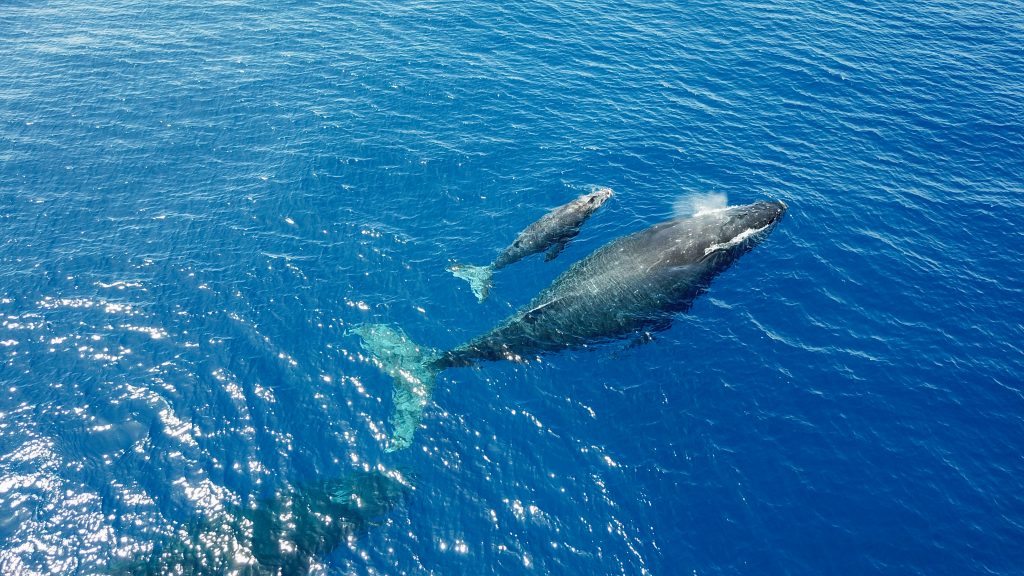Study: Climate change could adversely impact 65% of humpback whale breeding grounds this century

Findings of a collaborative study and subsequent scientific paper emphasize the need for governments to focus on the protection of critical ocean habitats, such as whale breeding grounds.
The study examines climate-change scenarios over a 100-year period to project potential impacts of rising sea surface temperatures on humpback whale breeding grounds.
High-Resolution Projections of Global Sea Surface Temperatures Reveal Critical Warming in Humpback Whale Breeding Grounds, was published in Frontiers in Marine Science and authored by PhD student Hannah von Hammerstein (Department of Geography and Environment, University of Hawai‘i at Mānoa). Co-authors include: PWF Chief Scientist Jens J. Currie, PWF Chief Biologist Stephanie H. Stack, PhD student Renee O Setter (Department of Geography and Environment, University of Hawai‘i at Mānoa) and PhD student Martin van Aswegen (Marine Mammal Research Program, Hawai‘i Institute of Marine Biology, University of Hawai‘i at Mānoa).

“Our goal was to refine our understanding of how climate change affects humpback whale breeding grounds while producing results that can benefit the protection of humpback whales worldwide,” von Hammerstein said in a press release, adding that bleaching corals and shore erosion from rising sea levels are already visible along the coasts of the Hawaiian Islands. “Hawai‘i, a place of rich biodiversity, is one of the few places worldwide where humpback whales come together yearly to breed.”
The study notes that each winter, humpbacks travel thousands of miles to mate and calve in the ’Au’au Channel off the coast of Maui and other tropical coastal waters in regions with sea surface temperatures ranging between 21 and 28°C.
“As anthropogenic greenhouse gas emissions trigger global climate changes and warm the world’s oceans at unprecedented rates, the sea surface temperatures in some of these tropical regions could exceed the normal range within the next century. Although global projections of sea surface temperatures exist and are a crucial tool in documenting the collective effects of climate change, they lack the detail and resolution to effectively analyze and predict regional temperature patterns necessary to project changes in humpback whale breeding grounds,” according to the PWF.
To better understand and anticipate the effect of climate change on regional sea surface temperatures, researchers say the collaborative research team produced large-scale projections of climatic variables.
Employing statistical analyses, the team projected sea surface temperatures around the world over each decade and illustrated shifting 21 and 28°C isotherms, which border the temperature envelope of humpback whales’ preferred breeding and calving grounds, over the course of the current century.
“The analysis was initially undertaken as a class project by PhD students at the University of Hawai‘i at Manoa. They had the idea to apply their method to humpback whales and measure changes to the ocean,” Stack said. “In order to pursue this idea, they invited co-authors from the UH Marine Mammal Research Program and PWF’s Research team to join the project and provide their knowledge of humpback whales to help interpret the climate projections.”
By mapping out future trajectories of two climate change scenarios, the study found that 35% of humpback whale breeding areas will experience temperatures above or within 1°C of the 28°C threshold if present-day social, economic and technological trends continue (‘middle of the road’ greenhouse gas trajectory).
Under the scenario depicting rapid economic growth in carbon-intensive industries (‘fossil-fueled development’ greenhouse gas trajectory), the number of adversely impacted breeding areas rises dramatically to 65%, according to the study. Researchers say, “If breeding grounds exceed 28°C, whales may cease using these areas which could not only compromise whales’ breeding rates, but also inflict economic hardship on countries that rely on whale-based tourism.”
“This project was a computer simulation of what the ocean will look like over the next 100 years. It was conducted by feeding existing climatic and emissions data to a computer model to project future changes and impacts on humpback migration,” said Stack. “This was not a field study, meaning we did not measure actual changes to the ocean or whale populations.”
According to PWF researchers Currie and Stack, this case study supports the need for global governments to focus on protecting critical ocean habitats through collectively reducing global greenhouse gas emissions, minimizing additional temperature increases and providing high-resolution climate data to preserve the ecological integrity of humpback whale breeding areas worldwide.
“This is just the beginning,” Stack concluded. “PWF’s Research program will continue to study major threats to cetaceans, including climate change, to better understand how they impact the migration of large whales as well as what management measures offer the greatest protection against these threats.”









